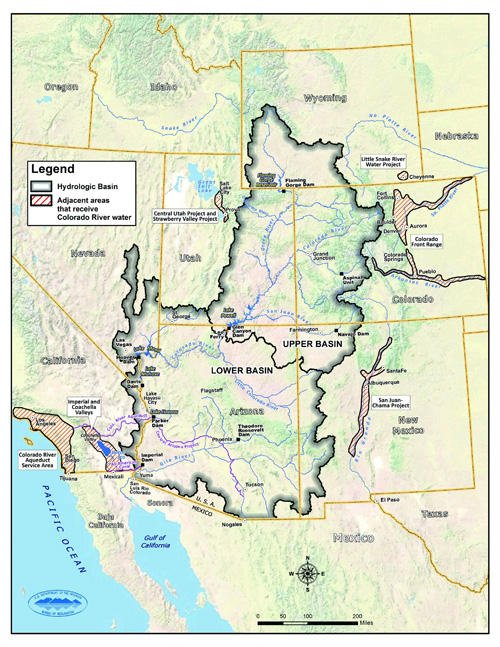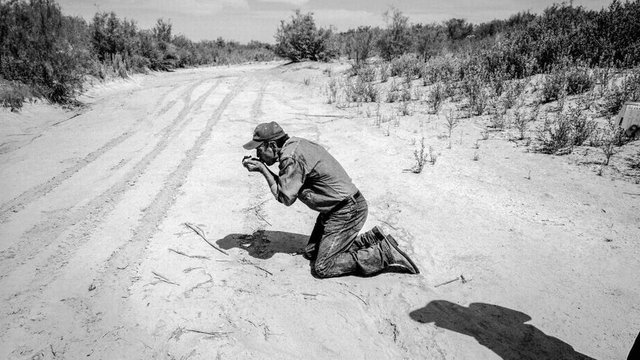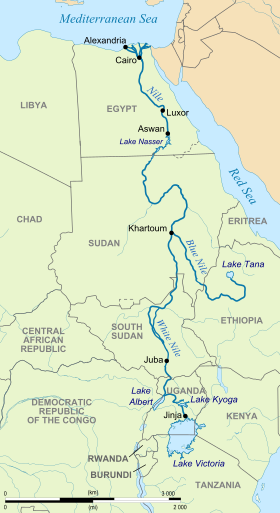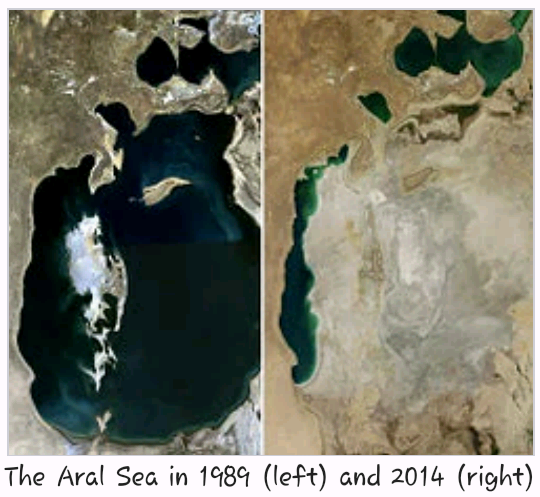Desertification
Every morning I assume most people wake up, use the toilet, brush their teeth, shower, have breakfast and head out to wherever they're going. In the course of the day they'll have lunch, snacks, some drinks and end the day with dinner and a shower. In total, this person will have used about 80litres of water which is quite a lot. All this water used will head out as wastewater and probably won't be recycled to the source. The impact in the end is that the source of all our domestic and industrial water will get depleted because it lacks replenishment.
For instance, take a look at the Colorado river that runs from the US to Mexico.

It boosts of 15 dams on the main stem and hundreds more on tributaries according to Wiki. In addition, water for irrigation, commercial, industrial and domestic use (for over 35million people) is also obtained from this river. Irrigation takes up to 70% of the rivers water. Dams hold atleast 4times the rivers annual flow. At the mouth which is the Gulf of Mexico, the delta covers less than 250 square miles down from 3000 in the 1920s. The river has completely dried up heading backwards for about 80 miles from the river mouth and it has been so for atleast twenty years.

The river now ends in Mexico's Morelos dam a few miles from the US-Mexico border. This means if all rivers are treated like this they will dry up.
Another river on a similar path is the river Nile flowing from Lake Victoria to the Mediterranean sea bordering Egypt.

Along the way we have several hydropower dams which include Nalubaale dam (formerly Owen falls dam), Kiira dam, Bujagali dam, 600MW Karuma dam (Kiryandongo district), 183MW Isimba dam(Kayunga and Kamuli districts), 80MW Rusumo dam(Rusumo district, River Kagera), 345MW Aswan high dam (Aswan, Egypt), Sennar dam(Sudan), 6400MW Grand Ethiopian Renaissance Dam(GERD), Al-Rusayris dam among others. Each dam is constructed to hold back the river water and create an artificial lake behind the dam. The lake then provides a large amount of water through a penstock to turn turbines and generate electricity. Basically convert mechanical energy to electrical energy. This means more and more water is held back after each dam and the river gets weaker downstream. Along the same river we have irrigation schemes that tap lots of water from the river to irrigate desert and arid farm lands in South Sudan, Sudan and Egypt. The livelihood of these countries lying in the Sahara is dependant upon this river. Water treatment plants to supply fresh water for domestic, commercial and industrial use also exist along this river. With all this water being taken from this river it is bound to dry up at some point. You could look at the source of the Nile and see a vast water body and you'd think I'm bananas for saying or even thinking the Nile could dry up but it is possible. Downstream is weakest and has much less water than up stream. To make matters worse, downstream is all desert.
Another case study is the Aral sea lying between Kazakhstan and Uzbekistan. Originally 68,000km2 (about half the size of UK) and more than 100 metres deep meaning it could handle big steam ships. Currently much less than a quarter of it is left. It's salty as opposed to the original almost fresh water and no ship in sight.

In the 1960s, the Amu Draya and Syr Draya rivers that fed the Aral sea were diverted to irrigate soviet cotton and food fields. Cotton was referred to as white gold at the time. Uzbekistan indeed became the world's largest exporter of cotton in the late 80s. Originally the 4th largest lake in the world it had shrank to 8th largest in a period of 40 years after losing 60% of its surface area and 80% of its volume. The sea had no outflow and therefore was originally slightly salty. Despite this fact it was almost as good as fresh water. 30 years after the diversion of its feeding rivers, the Aral sea was drying up very fast, had split into two and was more salty than the Dead Sea. It later split into four parts in the subsequent years. Winds blowing over the sea in addition to the hot summer weather drained it faster as well until mud and salt pans started appear. As of 1997, the sea had diminished to a tenth of its original size in 1960. Only the northern part in Kazakhstan and western part remain today. The eastern basin is today referred to as the Aralkum desert.
Continued use of water from water bodies without recycling back wastewater is catastrophic and could bring about desertification in the surrounding areas. Desertification is the process by which a geographical region becomes a desert due to human activities and climate. Desertification itself brings about climate change for example very cold winters and hot summers. Prolonged and rearranged wet and dry seasons in the tropics. Climate change is real and it might finish off the human race well before any war, pandemic or alien attack.
Solution;
Use less water. Save water even if your landlord is giving you free water. Use less water to do your chores and hygiene practices. Water used daily should not exceed 40 litres per person. Less strain on water bodies means they won't dry up.
Recycle wastewater. Wastewater treatment plants could help to reduce the strain on water bodies and solve water problems for some areas.
Plant trees. Cut one plant three. Trees help to raise the water table as their roots stretch down into the soil. The water that usually heads deep down is encouraged to stay up for trees to use. Trees also provide cover and help in rain formation through transpiration.
In arid and already desertified areas with seasonal rainfall, big ditches can be dug to harvest water and trees plants planted close to the ditches. As the trees grow they help in rain formation. They also attract and house birds which bring with them more plant seeds. Trees also raise the water table. It is believed that wherever a desert exists, it was once wet and therefore vast amounts of water sit right below the scorching dryness.
We do need to use less. Depending on where we are, we definitely take water for granted.
Indeed. Short showers need to be adopted. No singing or crying or whatever in the shower. Take that outside
Hii im just follow u pls follow me back thanks
Send ur any post link in my comment box I will definitely upvote it
https://steemit.com/photography/@rohanmore/2dt5xk-my-photography-7